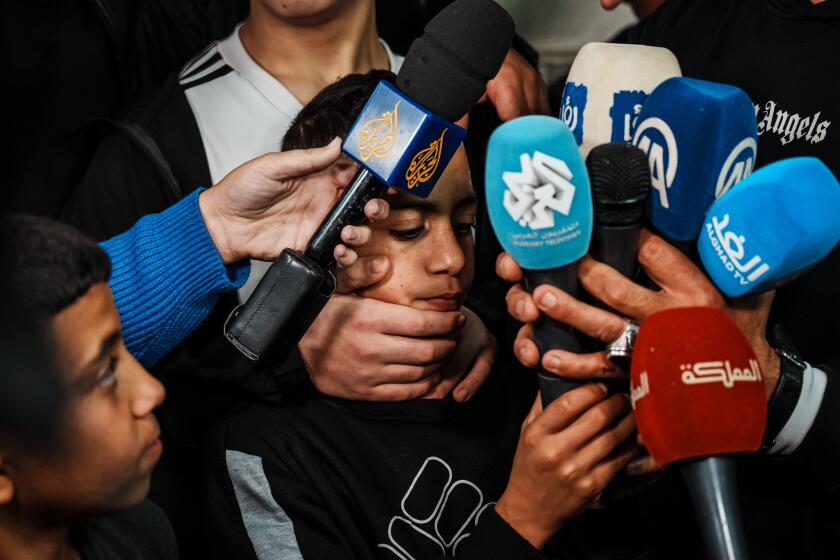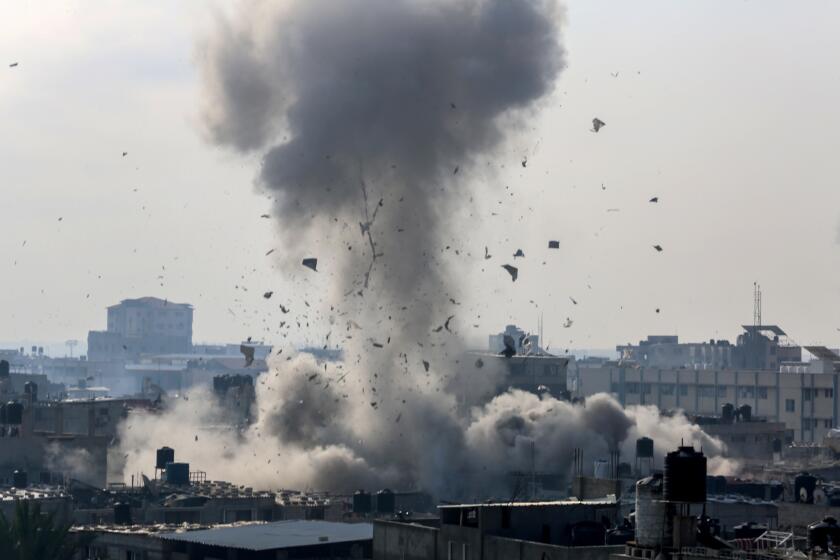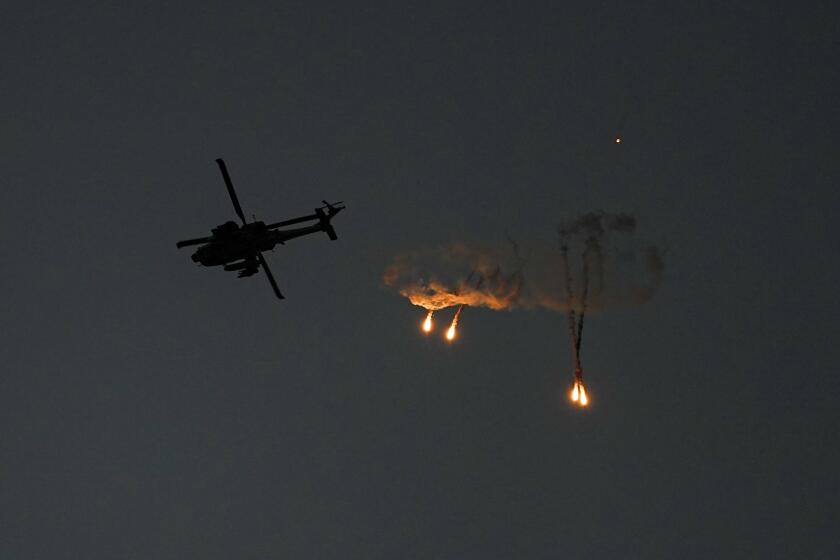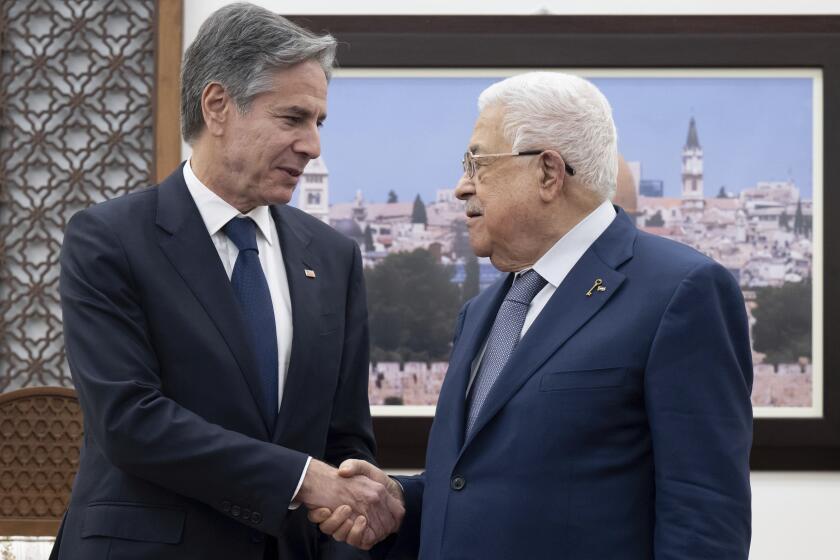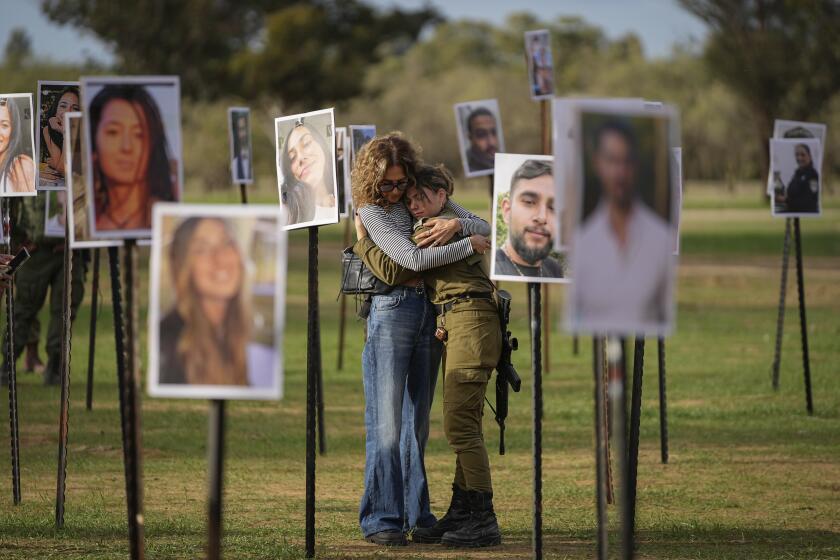‘There is no place to go.’ Israeli attacks shift to crowded southern Gaza, driving up death toll
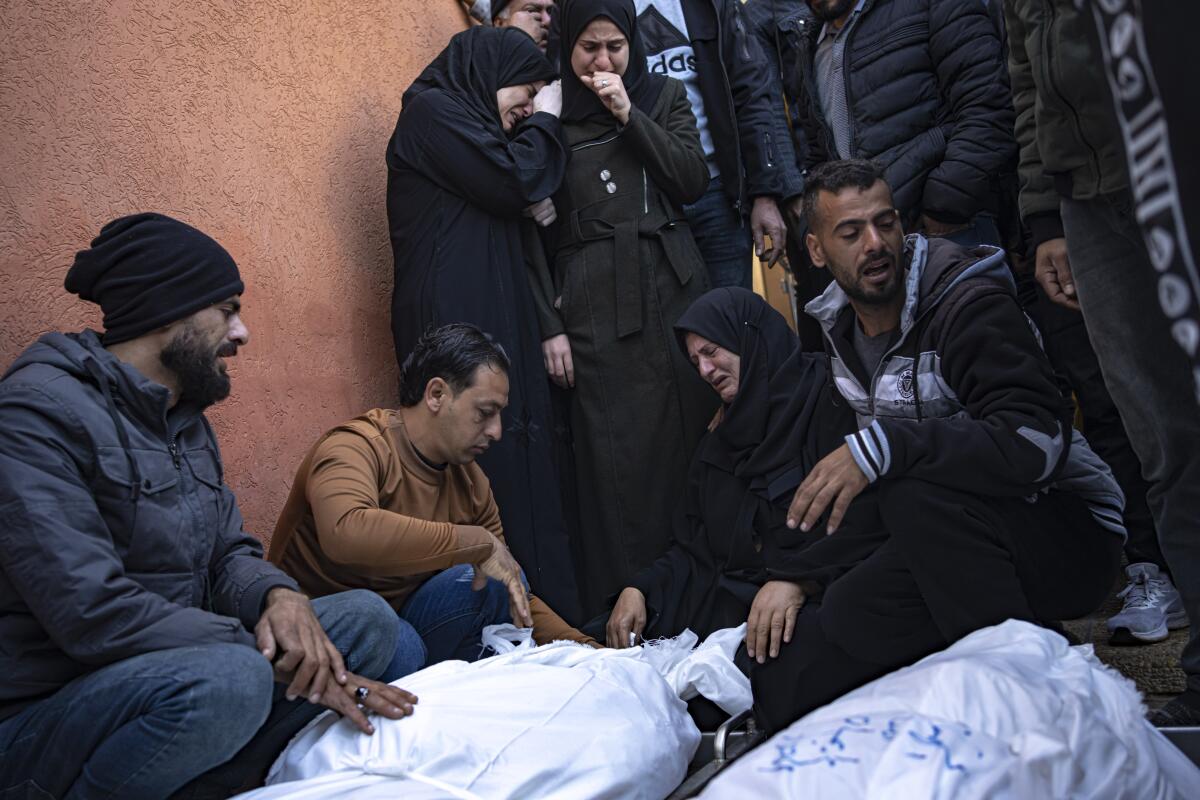
- Share via
KHAN YUNIS, Gaza Strip — Israel pounded targets in the crowded southern half of the Gaza Strip on Saturday and ordered more neighborhoods designated for attack to evacuate, driving up the death toll even as the United States and others urged it to do more to protect Gaza civilians a day after a truce collapsed.
The prospect of further cease-fires in Gaza appeared bleak, as Israel recalled its negotiators and Hamas’ deputy leader said any further swap of Gaza-held hostages for Palestinians imprisoned by Israel would only happen as part of ending the war.
“We will continue the war until we achieve all its goals, and it’s impossible to achieve those goals without the ground operation,” Prime Minister Benjamin Netanyahu said in an address Saturday night.
At least 200 Palestinians have been killed since the fighting resumed Friday morning following the weeklong truce with the territory’s ruling militant group Hamas, according to the Health Ministry in Gaza. Several multi-story residential buildings were hit on Saturday, engulfing neighborhoods in huge clouds of smoke.
Separately, the ministry announced that the overall death toll in Gaza since the Oct. 7 start of the latest Israel-Hamas war surpassed 15,200, a sharp jump from the previous count of more than 13,300 on Nov. 20. The ministry does not differentiate between civilians and combatants, but it said Saturday that 70% of the dead were women and children. It also said more than 40,000 people had been wounded since the start of the war.
The recent hostage-for-prisoner swaps between Hamas and Israel have focused attention on the number of Palestinian minors imprisoned by Israel.
“Too many innocent Palestinians have been killed. Frankly, the scale of civilian suffering and the images and videos coming from Gaza are devastating,” Vice President Kamala Harris told reporters at the COP28 climate conference in Dubai.
Appeals from the U.S., Israel’s closest ally, came after blistering air and ground attacks in the first weeks of the war devastated large areas of northern Gaza, killing thousands of Palestinians and displacing hundreds of thousands.
After the attacks and Israeli orders for Gazans to evacuate to the south, some 2 million Palestinians, almost the entire population of Gaza, are now crammed into the territory’s southern half.
The Israeli military said Saturday that it hit more than 400 Hamas targets across Gaza over the last day, including more than 50 strikes in the city of Khan Yunis and surrounding areas in the south.
Palestinian Red Crescent spokesman Mahmoud Basal told broadcaster Al Jazeera that there were more than 300 “martyrs” in Gaza City’s Shujaiya neighborhood and that homes were flattened. Israel’s military said it killed Hamas’ Shujaiya battalion commander but gave no details. Residents could not be reached.
In northern Gaza, an airstrike flattened a building hosting displaced families in the urban refugee camp of Jabaliya on the outskirts of Gaza City. The strike on the multi-story building left dozens dead or wounded, said residents Hamza Obeid and Amal Radwan.
“There was a loud bang, then the building turned into a pile of rubble,” Obeid said.
Israel bombs Gaza and Hamas aims rockets at Israel as top U.S. diplomat departs region. But now-expired truce saw scores of Israeli hostages and hundreds of Palestinian prisoners freed.
Associated Press video showed smoke rising as men, some in sandals, picked their way over debris. The Israeli military confirmed it was operating in Jabaliya and said it had found and destroyed Hamas tunnels in the surrounding area.
And a powerful strike hit a cluster of multi-story buildings in Hamad City, a Qatari-funded housing development on the outskirts of Khan Yunis. Smoke engulfed the complex. There was no immediate word on casualties.
“Where is it safe? I swear to God, no one knows, where are we going?” asked Zohair al Raai, who said his family received a recorded message saying their building should evacuate.
Also in the south, at least nine people, including three children, were killed in a strike on a house in Deir al Balah, according to the hospital where bodies were taken.
Meanwhile, Palestinian militant groups in Gaza said they fired a barrage of rockets on southern Israel. Lt. Col. Peter Lerner, an Israeli army spokesperson, said Hamas had launched more than 250 since the cease-fire ended. There were no immediate reports of injuries.
With the resumption of fighting, the Israeli military published an online map carving up the Gaza Strip into hundreds of numbered parcels and asked residents to familiarize themselves with the number of their location ahead of evacuation warnings.
On Saturday, the military used the map for the first time, listing more than two dozen parcel numbers in areas around Gaza City in the north and east of Khan Yunis. Separately, the military dropped leaflets with evacuation orders over towns east of Khan Yunis.
One Khan Yunis resident said a neighbor received a call from the Israeli army warning that houses in the area would be hit and everyone should leave. “We told them, ‘We have nothing here, why do you want to strike it?’” said the resident, Hikmat al Qidra. They eventually left, and Al Qidra said the house was destroyed.
A Times special correspondent in Gaza offers a personal account of living in a place where nowhere feels safe.
The maps and leaflets generated panic and confusion, especially in the crowded south. Unable to go to northern Gaza or neighboring Egypt, their only escape is to move around within the 85-square-mile area.
“There is no place to go,” said Emad Hajar, who fled with his wife and three children from the north a month ago to Khan Yunis. “They expelled us from the north, and now they are pushing us to leave the south.”
Israel says it targets Hamas operatives and blames civilian casualties on the militants, accusing them of operating in residential neighborhoods. It claims to have killed thousands of militants, without providing evidence. Israel says 77 of its soldiers have been killed in northern Gaza.
The Biden administration views the two-state solution — an independent Palestinian state alongside Israel — as the only way to stop generations of violence.
Also Saturday, the Palestinian Red Crescent said it had received aid trucks through the Rafah crossing, the first convoy since fighting resumed. Wael Abu Omar, a spokesman for the Palestinian crossings authority, said 100 trucks entered, including three carrying nearly 40,000 gallons of fuel.
“Current conditions do not allow for a meaningful humanitarian response, and I fear will spell disaster for the civilian population,” Pascal Hundt, in charge of operations in Gaza for the International Committee of the Red Cross, said in an earlier statement about Israel’s blockade of Gaza.
Meanwhile, Harris said in a meeting with Egyptian President Abdel Fattah Sisi that “under no circumstances” would the United States permit the forced relocation of Palestinians from Gaza or the West Bank, the besiegement of Gaza or the redrawing of its borders, according to a U.S. summary of the meeting.
As the Palestinian militant group Hamas frees more hostages amid a temporary truce with Israel, a harrowing glimpse of captivity in war-torn Gaza emerges.
The Oct. 7 attack by Hamas and other militants killed about 1,200 people, mostly civilians, in southern Israel, and around 240 people were taken captive, according to the Israeli government.
The renewed hostilities have heightened concerns for 137 hostages who, according to the Israeli military, are still held by Hamas and other militants after 105 were freed during the truce.
For families of remaining hostages, the truce’s collapse was a blow to hopes that their loved ones could be the next out. A 70-year-old woman held by Hamas was declared dead on Saturday, according to her kibbutz, bringing the total number of known dead hostages to eight.
At a rally of tens of thousands in Tel Aviv, released hostages called for the rest to be freed.
In a video address, Yaffa Adar, 85, spoke up specifically for children being held, saying, “I want to see them now — not when I’m in a coffin.”
Hamas and Israel differed on who was still being held.
Hamas’ deputy leader, Saleh Arouri, told Al Jazeera that any remaining hostages are men, “all of whom served in the [Israeli] army.” That contradicted another top Hamas official, Osama Hamdan, who told the Associated Press on Friday the group was willing to trade more hostages but rebuffed an Israeli demand to release 10 female soldiers.
Israel’s Defense Minister Yoav Gallant said Hamas violated the truce agreement by refusing to return two children and 15 women.
During the truce, Israel freed 240 Palestinians from its prisons. Most of those released by both sides were women and youths.
Jobain reported from Khan Yunis, Magdy from Cairo and Rising from Bangkok. Associated Press writer Julia Frankel in Jerusalem contributed to this report.
More to Read
Sign up for Essential California
The most important California stories and recommendations in your inbox every morning.
You may occasionally receive promotional content from the Los Angeles Times.
